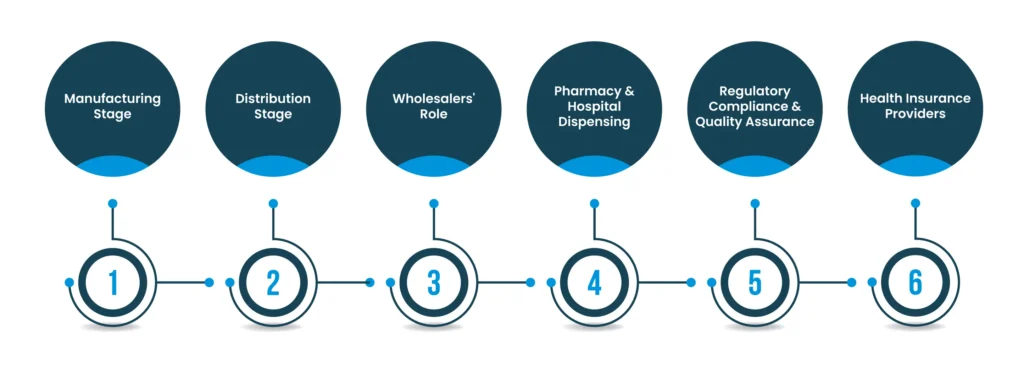

The healthcare supply chain, the complex network behind delivering medications, equipment, and other essentials to patients, often goes unnoticed. But for healthcare providers like you, it’s the invisible backbone supporting every diagnosis, treatment, and procedure.
In this blog, we’ll delve into the world of the healthcare supply chain, exploring its various stages, challenges, and emerging trends. We’ll equip you with the knowledge to navigate this crucial system effectively, ensuring your patients receive the right supplies at the right time, every time.
So, buckle up and prepare to gain valuable insights into the world of healthcare supply chain. Let’s begin!
Imagine you’re treating a patient, ready to administer the perfect medication. But it’s nowhere to be found. Stock is low, delivery is delayed, and precious treatment time melts away. This, unfortunately, is a harsh reality for many healthcare providers due to disruptions in the supply chain management in healthcare.
But what exactly is this complex system, and why should you, as a busy healthcare professional, understand it? You may think what is healthcare supply chain management.
Think of the supply chain in healthcare as a vast, interconnected web. It stretches from the research and development of medicines and equipment to their manufacturing, distribution, and finally, delivery to your hands. Each stage involves numerous players – researchers, manufacturers, distributors, hospitals, and even you – all working together.
The workflow of supply chain management in the healthcare industry involves multiple stakeholders working collaboratively to ensure the efficient production, distribution, and dispensing of medicines and healthcare supplies to patients across the country, while also prioritizing regulatory compliance and quality assurance.

Supply chain management is crucial in healthcare, particularly after COVID-19 exposed vulnerabilities. The pandemic caused shortages and disruptions, emphasizing the need for better management to ensure timely access to medical supplies.
Efficient supply chains are key to achieving high-quality care, service availability, and lower costs. They help optimize inventory, streamline processes, and minimize waste, leading to cost savings without compromising quality.
Healthcare providers face increased pressure to cut costs while improving patient outcomes and reimbursement. Effective supply chain management is essential for addressing these challenges. It helps identify cost-saving opportunities, enhance operational efficiency, and ensure resources are available for optimal care delivery.
Even before the global upheaval caused by COVID-19, hospital supply chains faced a multitude of hurdles. Now, with the added pressure of pandemics and economic uncertainties, these challenges have become even more critical to address. As healthcare professionals, understanding these challenges is crucial, as it allows us to advocate for better solutions and contribute to a more resilient system.
Here are some of the key challenges associated with hospital supply chain management:
From navigating global disruptions to optimizing costs, ensuring patient safety, and complying with regulations, these dynamic systems face many challenges. Thankfully, there are best practices that hospitals can implement to navigate this complex maze and achieve a more efficient, resilient, and patient-centric supply chain.
Work Together as a Team:
Encourage everyone in your hospital to work together and share information. Team up with other hospitals to buy supplies in bulk and save money. Be open about how well you’re doing and always try to get better.
While often unseen, the healthcare supply chain plays a vital role in shaping patient health outcomes. The intricate network ensures the right medications, equipment, and supplies reach the right patients at the right time. Let’s see it by an example:
Imagine a patient diagnosed with a critical illness, needing a specific medication immediately. A well-managed supply chain ensures the medication is readily available, preventing delays that could worsen the patient’s condition. This timely access to treatment can significantly improve treatment efficacy and patient prognosis.
The supply chain plays a crucial role in safeguarding patient safety. Robust quality control measures throughout the chain, from manufacturing to distribution, prevent the use of counterfeit or contaminated products. This reduces the risk of adverse reactions and infections, ensuring patients receive safe and effective treatment.
Efficient supply chain management can optimize costs, making essential treatments more accessible to patients. This can be achieved through negotiating better prices with vendors, reducing waste, and optimizing inventory levels. By lowering costs, the supply chain helps ensure patients receive the care they need without facing financial hardship.
A recent study analyzed the impact of improved supply chain management on cancer treatment outcomes in a large hospital network. The study found that hospitals with efficient supply chains experienced:
This example highlights the tangible impact a well-managed supply chain can have on patient health outcomes. By ensuring timely access, quality, affordability, and innovation, the healthcare supply chain plays a crucial role in shaping the lives of patients around the world.
The Future Trends In Medical Supply Chain Management
The healthcare landscape is constantly evolving, and so too is the medical supply chain. While challenges remain, exciting advancements are paving the way for a more efficient, resilient, and patient-centric future. Let’s delve into the crystal ball and explore some of the key trends shaping the future of medical supply chain management:
Repetitive tasks like inventory management and order processing will be increasingly automated, freeing up human resources for more strategic tasks. Expect to see robots handling stock replenishment, autonomous drones delivering supplies within hospitals, and AI-powered systems optimizing ordering and distribution.
Blockchain technology, known for its secure and transparent nature, will play a key role in assuring product authenticity and tracking supplies throughout the chain. This will combat counterfeit products, improve traceability, and enhance patient safety.
Advanced analytics will be leveraged to gain deeper insights into supply chain data. Predictive models will anticipate demand fluctuations, optimize inventory levels, and identify potential disruptions before they occur, leading to more informed and proactive decision-making.
Hospitals and other healthcare providers will increasingly collaborate to form strategic alliances and joint purchasing initiatives. This will leverage economies of scale, optimize resource allocation, and improve overall supply chain efficiency.
3D printing technology has the potential to revolutionize medical supply chain management. Imagine on-demand printing of customized prosthetics, surgical instruments, and even personalized medications in hospitals, reducing lead times and improving patient care.
Environmental sustainability will be a major focus, with healthcare institutions prioritizing eco-friendly packaging, reducing waste, and adopting green logistics practices. This will not only benefit the environment but also contribute to cost optimization.
Artificial intelligence will be used to develop sophisticated demand forecasting models that account for various factors like disease outbreaks, seasonal variations, and local trends. This will enable hospitals to anticipate and meet patient needs more effectively, preventing stockouts and unnecessary costs.
Talk to an Expert Now